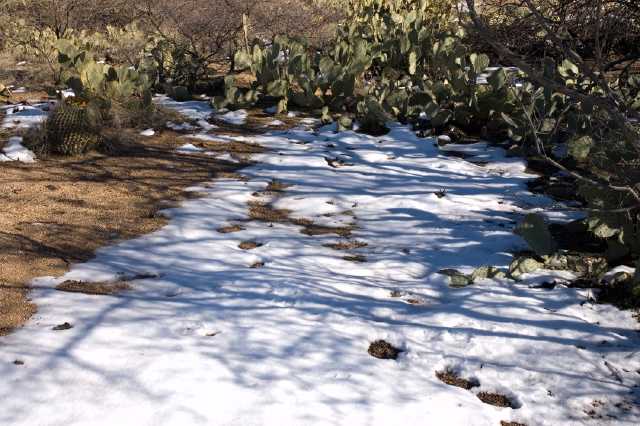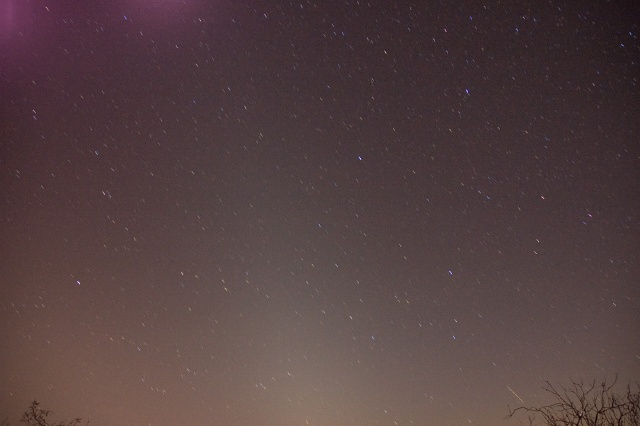|
|
O R A C L E O B S E R V A T O R Y Report 6-7 February 2008 |
|
|
During January 2008 I replaced a few of the items that were stolen last month so that I could get back to observing with my ETX telescopes and doing some astrophotography. Following a storm that resulted in up to a foot of snow in some areas of Oracle on 4 February, the skies were forecast to be clear on the 6th and 7th. So I made the 20 minute drive to Oracle; now that we have moved to Arizona, Oracle is a lot closer than the 8.5 hour drive I had been making for the past two years!
When I arrived at 1330 MST the temperature was 48°F under clear skies. There were some patches of snow remaining as you can see in the following photographs. I didn't complete the setup until 1530 as it was necessary to scope out a new location for my tent; where I normally set up the tent was covered in snow:

Fortunately, where I have set up the telescope in the past was clear of snow and I could put the tent nearby. Here's the setup:

Here's a closeup of the setup showing the ETX-90RA on the left and the ETX-125AT on the right.

I had some time to kill before Sunset so I took some photos of the snow at Oracle Observatory. This was my first trip here when there was snow on the ground.







It certainly made some nice scenes with the snow and cactus plants!
I could see some clouds low in the West as the afternoon progressed so I began to wonder how the viewing conditions would be that night. So I pulled out my Apple iPhone and checked. The AT&T EDGE network is usable from Oracle Observatory so I was able to check the weather forecast sites and the ClearSkyClock web page as seen on my main Oracle Observatory page. The forecast remained for Clear Skies. As the Apple ads say, it sure is handy to have the real Web available from my phone (and iPod)!
At Sunset I caught these two bunnies checking out my Prius!

Sunset occurred at 1801 MST and the temperature was down to 39°F.

Here are the telescopes, ready for action.

By 1915 the temperature was 32°F and the skies were clear. I decided to do some more testing of the Meade mySKY. You can read my report on the "mySKY Review" page on my ETX Site.
By 1930 MST the Winter Milky Way was clearly visible crossing from the Northwest, overhead to the Southeast. Very nice! And then I noticed the Zodiacal Light was visible in the West!!! This was only the third time I have seen it, the first and second being from Oracle Observatory in February 2007 and then again in March 2007. It was clearly visible as a faint glow of light rising from the horizon up about 45 degrees (almost halfway to the Zenith!).
At 2000 MST I started viewing some Deep Sky Objects using the ETX-125. I used a 40mm eyepiece (48X) which provided a nice bright wide field view. Over the next 45 minutes I enjoyed looking at objects like M42 (the Great Nebula in Orion; which had a lot of detail visible in the 40mm eyepiece), M31 (the Andromeda Galaxy), M1 (the Crab Nebula, which also showed a lot of detail), and M45 (the Pleiades, which looked like a lot of bright diamonds on black velvet). I even managed to catch sight of a few nice, fast moving, meteors. Tip: when using a telescope remember to look up into the night sky occasionally! I then switched to the ETX-90. I used a 26mm eyepiece and a 26mm eyepiece in combination with a Wide Field Adapter. M42 was especially nice in the ETX-90 with the 26mm and Wide Field Adapter. By 2045 it was down to 30°F and I froze out! So I decided to call it a night and head off to the "Astronomer's Quarters" (the tent) and that (I hoped) warm sleeping bag.
At 0830 MST the next morning I finally decided to venture out of the "warm" tent (it was 30 degrees inside overnight!). Outside it was 33°F under clear skies. I did some reading (Mac OS X Leopard: The Missing Manual) during the morning and then I took some photos of some quail:



By 1320 it had warmed up to 56°. I had planned to bring my PST (Coronado "Personal Solar Telescope") to do some solar observing but I forgot it at home. I did have my Coronado "White Light Solar Filter" for my ETX-90 so I used that for some viewing of the Sun. There were no sunspots visible today. In preparation for this month's Total Lunar Eclipse on the 20th I took a test photograph of the Sun through the ETX-90 using the Wide Field Adapter, OPT Camera Adapter, and my Nikon D70 DSLR. (I will have a full review of the OPT Camera Adapter at a future date.) With the Wide Field Adapter the Sun did not fill the camera's field of view as can be seen here:

Since the Moon will be approximately the same visual size as the Sun during the eclipse I know that I should be able to get some nice images (whether permitting, of course) of the eclipsed moon with the ETX-90.
I noticed during the afternoon that the snow had mostly melted away around Oracle Observatory. At 1630 I had a visit from this bunny:

At 1744 with the temperature at 47°F this powered hang glider appeared in the Northwest:


At 1745 I decided that I would not stay this night (I had had enough of the cold!) and packed up a few items. But I knew that I wanted to try for a photograph of the Zodiacal Light. Shortly after 1900 MST, with the temperature at 36° I took some photos of the Western sky. The best one that shows the Zodiacal Light was taken at 1919:

The photograph was taken with my Nikon D70 DSLR and was a 2 minute exposure at ISO 1600 with the lens set at 18mm focal length. Can you see the Zodiacal Light in the image? It is visible as a thin vertical wedge running from the bottom center where it is at its widest, upward and slightly left almost to the top of the image. (Tip: don't stare at the photo; look off to the side or bottom. Yes, using "averted vision" even helps with photos!)
I began packing up the remaining items at 1940 (temperature 34°F). I left Oracle Observatory at 2040, arriving back home at 2100. Yes, that 20 minute drive is sure faster than the 8.5 hours it used to take to get home!!!
I didn't do any night time astrophotography through the telescopes as I'm still replacing stolen items. I do plan to return to Oracle Observatory (weather permitting) for the Total Lunar Eclipse on 20 February and hope to get some good photos of it. Stay tuned.